
CCIA
Consumer Credit Industry Association
1300 Pennsylvania Ave., NW
190 #327
Washington, DC 20004
Tom Keepers
Executive Director & EVP
608.848.4484
October 26, 2020
Board of Governors of the Federal Reserve System
Submitted via email: [email protected]v
Re: Interagency Questions and Answers Regarding Flood Insurance for Loans in Areas Having
Special Flood Hazards, Docket
No.
OP-1720
Dear Board of Governors,
The Consumer Credit Industry Association ("CCIA") appreciates the opportunity to comment on
the proposed Interagency Questions and Answers Regarding Flood Insurance
for
Loans in Areas
Having Special Flood Hazards ("Interagency Q&A").
CCIA is a national trade association representing manufacturers, administrators and distributors
of lender and consumer protection products such as lender-placed flood insurance. Since our
members are "providers" of force placed flood insurance, our comments start with the FORCE
PLACEMENT questions and then transition into other areas that have implications to force
placed flood insurance as well.
Regardless of the outcome of this Interagency Q&A, industry will continue to execute processes
that help assure safety and soundness for lenders while making the process as consumer-centric
as possible. There simply
is
no incentive for industry not to adhere to force placed flood insurance
requirements and we
offer
our comments in that spirit.
An overarching theme in this material focuses on
defining
what lender actions constitute making
a "determination" that flood insurance is absent or inadequate and whether that determination
(or those actions) are in fact conditional or does that determination prompt a certain consistent
obligation of the lender in all cases.
First is the specific use of the verb "determine" in describing the process a lender follows to
establish whether a loan is, or is not, adequately insured. Second is that notice to the borrower
follows determination and third, that placement follows notice - there is a specific obligation of
the lender or their servicer to provide notice after "determining" an absence or insufficiency in
coverage.
Additionally, the National Flood Insurance Act ("Act") describes the lender's duty to "determine"
sufficiency "at any time during the term of the loan" which we see as assigning no conditions as
to whether an individual determination should, or should not, be performed. This language
emphasizes the relationship between the act of determining coverage to be absent or insufficient
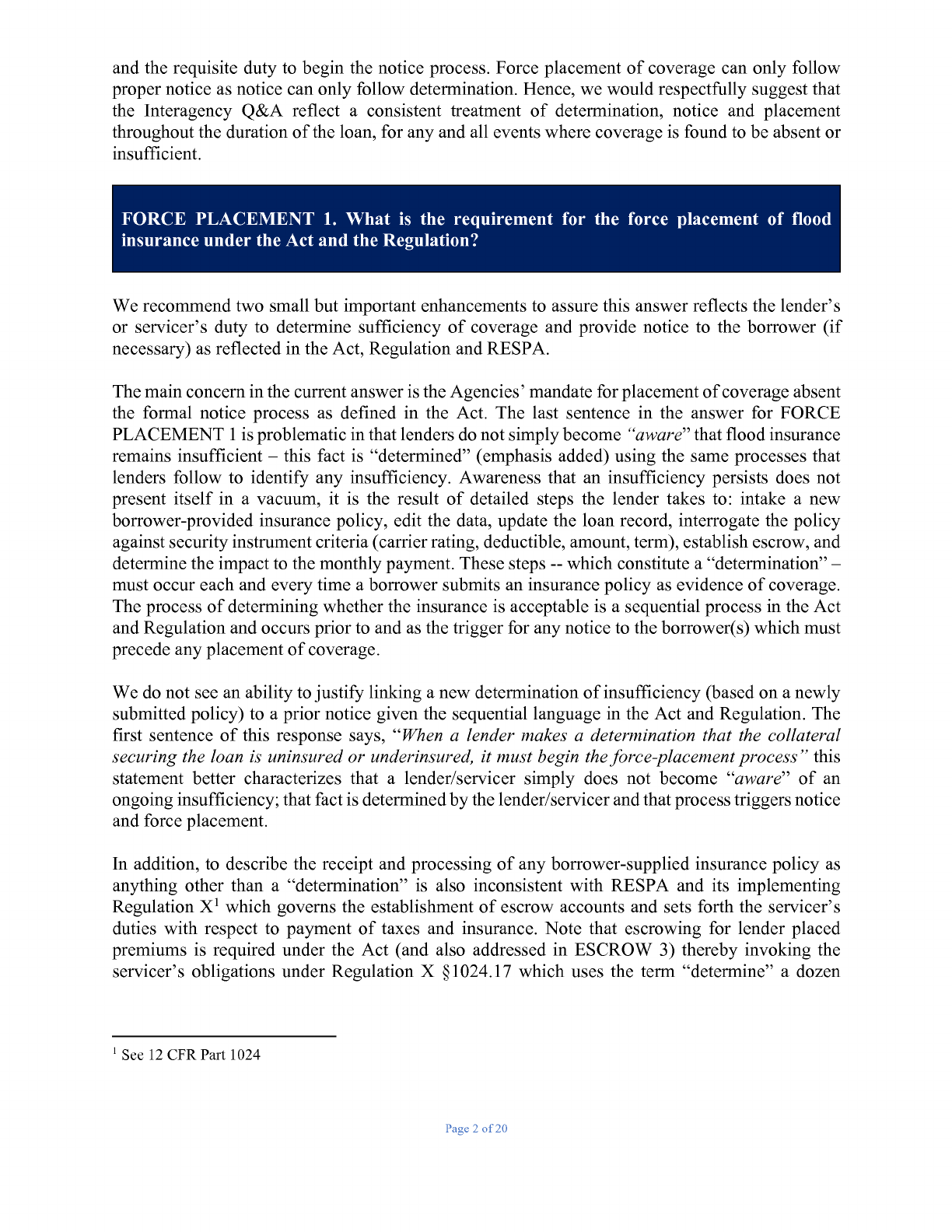
and the requisite duty to begin the notice process. Force placement of coverage can only follow
proper notice as notice can only follow determination. Hence, we would respectfully suggest that
the Interagency Q&A reflect a consistent treatment of determination, notice and placement
throughout the duration of the loan, for any and all events where coverage is found to be absent or
insufficient.
FORCE PLACEMENT 1. What is the requirement for the force placement of flood
insurance under the Act and the Regulation?
We recommend two small but important enhancements to assure this answer reflects the lender's
or servicer's duty to determine sufficiency of coverage and provide notice to the borrower (if
necessary) as reflected in the Act, Regulation and RESPA.
The main concern in the current answer is the Agencies' mandate for placement of coverage absent
the formal notice process as defined in the Act. The last sentence in the answer for FORCE
PLACEMENT
1
is problematic in that lenders do not simply become "aware" that flood insurance
remains insufficient - this fact is "determined" (emphasis added) using the same processes that
lenders follow to identify any insufficiency. Awareness that an insufficiency persists does not
present itself in a vacuum, it is the result of detailed steps the lender takes to: intake a new
borrower-provided insurance policy, edit the data, update the loan record, interrogate the policy
against security instrument criteria (carrier rating, deductible, amount, term), establish escrow, and
determine the impact to the monthly payment. These steps
—
which constitute a "determination" -
must occur each and every time a borrower submits an insurance policy as evidence of coverage.
The process of determining whether the insurance is acceptable is a sequential process in the Act
and Regulation and occurs prior to and as the trigger for any notice to the borrower(s) which must
precede any placement of coverage.
We do not see an ability to justify linking a new determination of insufficiency (based on a newly
submitted policy) to a prior notice given the sequential language in the Act and Regulation. The
first sentence of this response says, "When a lender makes a determination that the collateral
securing the loan is uninsured or underinsured, it must begin the force-placement process" this
statement better characterizes that a lender/servicer simply does not become "aware" of an
ongoing
insufficiency;
that
fact is
determined by the lender/servicer and that process triggers notice
and
force
placement.
In addition, to describe the receipt and processing of any borrower-supplied insurance policy as
anything other than a "determination" is also inconsistent with RESPA and its implementing
Regulation X
which governs the establishment of escrow accounts and sets forth the servicer's
duties with respect to payment of taxes and insurance. Note that escrowing for lender placed
premiums is required under the Act (and also addressed in ESCROW 3) thereby invoking the
servicer's obligations under Regulation X §1024.17 which uses the term "determine" a dozen
1
See 12 CFR Part 1024
1
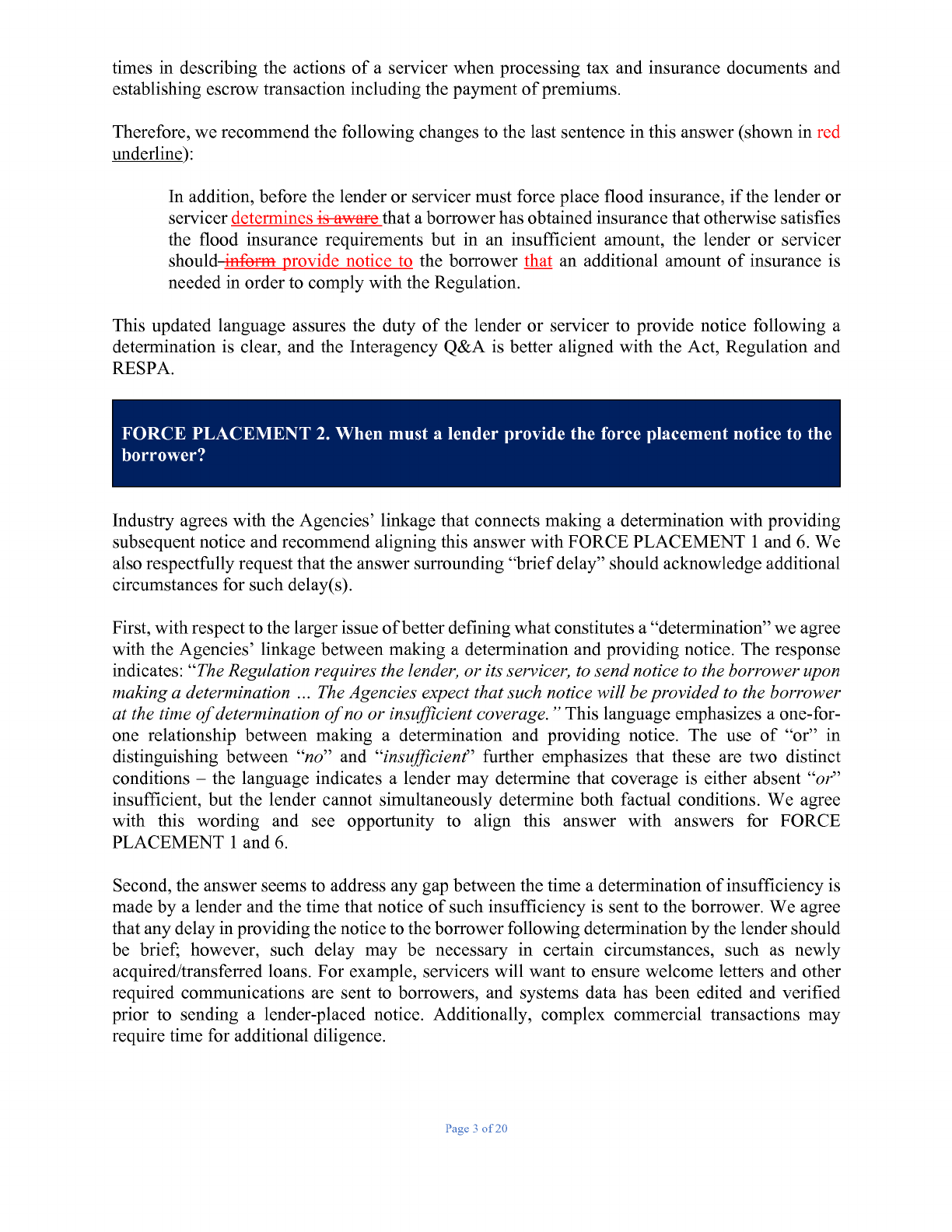
times in describing the actions of a servicer when processing tax and insurance documents and
establishing escrow transaction including the payment of premiums.
Therefore, we recommend the following changes to the last sentence in this answer (shown in red
underline):
In addition, before the lender or servicer must force place flood insurance, if the lender or
servicer determines is aware that a borrower has obtained insurance that otherwise satisfies
the flood insurance requirements but in an insufficient amount, the lender or servicer
should
inform
provide notice to the borrower that an additional amount of insurance is
needed in order to comply with the Regulation.
This updated language assures the duty of the lender or servicer to provide notice following a
determination is clear, and the Interagency Q&A is better aligned with the Act, Regulation and
RESPA.
FORCE PLACEMENT 2. When must a lender provide the force placement notice to the
borrower?
Industry agrees with the Agencies' linkage that connects making a determination with providing
subsequent notice and recommend aligning this answer with FORCE PLACEMENT
1
and 6. We
also respectfully request that the answer surrounding "brief delay" should acknowledge additional
circumstances for such delay(s).
First, with respect to the larger issue of better defining what constitutes
a
"determination" we agree
with the Agencies' linkage between making a determination and providing notice. The response
indicates: "The Regulation requires the lender, or its servicer, to send notice to the borrower upon
making
a
determination ... The Agencies expect that such notice will be provided
to
the borrower
at the time of determination of no or insufficient coverage." This language emphasizes a one-for
one relationship between making a determination and providing notice. The use of "or" in
distinguishing between "no" and
"insufficient"
further emphasizes that these are two distinct
conditions - the language indicates a lender may determine that coverage is either absent "or"
insufficient, but the lender cannot simultaneously determine both factual conditions. We agree
with this wording and see opportunity to align this answer with answers for FORCE
PLACEMENT
1
and 6.
Second, the answer seems to address any gap between the time a determination of insufficiency is
made by a lender and the time that notice of such insufficiency is sent to the borrower. We agree
that any delay in providing the notice to the borrower following determination by the lender should
be brief; however, such delay may be necessary in certain circumstances, such as newly
acquired/transferred loans. For example, servicers will want to ensure welcome letters and other
required communications are sent to borrowers, and systems data has been edited and verified
prior to sending a lender-placed notice. Additionally, complex commercial transactions may
require time for additional diligence.
-

Therefore, where "brief delay" is noted in the current response, we ask the Agencies to elaborate
by listing additional circumstances where the servicer is solving for further obligations and an
improved customer experience, such as inserting something similar to the following (shown in red
underline):
The Agencies expect that such notice will be provided to the borrower at the time of
determination of no or insufficient coverage. The Agencies recognize there may be brief
delays between determination and such notice, which can be caused by a number of
processes, including but not limited to batch processing, manual exception processing,
commercial transactions and newly acquired/transferred loans. If there is a brief delay in
providing the notice, the Agencies will expect the lender or servicer to provide a reasonable
explanation for the delay, for example, that the lender uses batch processing to send the
force-placement notice to its borrowers.
FORCE PLACEMENT
4.
May a lender satisfy its notice requirement by sending the force-
placement notice to the borrower prior to the expiration of the flood insurance policy?
We agree with this wording in that it reflects the intent and specificity in the Act and Regulation:
lenders must ensure that notice is provided upon determining (verifying) that the policy has
actually lapsed or is insufficient.
This clarification of cause-and-effect and restatement of the lender's obligations under the Act is
crucial for greater consistency in the application of this position specific to all determinations of
an absence or insufficiency in coverage. The Act and Regulation do not describe any conditions
or other factors that otherwise exempt a lender from providing notice any time they determine
coverage to be insufficient.
FORCE PLACEMENT 6. Once a lender makes a determination that a designated loan
has no or insufficient flood insurance coverage and sends the borrower a force-placement
notice, may a lender make a subsequent determination in connection with the initial
notification period that the designated loan has no or insufficient coverage and send
another force-placement notice, effectively providing more than 45 days for the borrower
to obtain sufficient coverage?
We urge the Agencies to reconsider the answer to this question and allow for lenders to make
subsequent determination(s) with subsequent notice(s) and corresponding placement of force
placed flood insurance (if necessary). In this way, the answer is aligned with the Act, other answers
in the FORCE PLACEMENT section, and well-established and examined industry practices.
Consistent Standards. A core issue
is
applying
a
consistent standard when referencing the process
of "determining" coverage to be adequate. There is no question as to whether a lender "may"
make a subsequent determination, rather, they are obligated to do so. Per RESPA, the security
instrument language and the Act, any examination of sufficiency is done on a per-policy basis
—
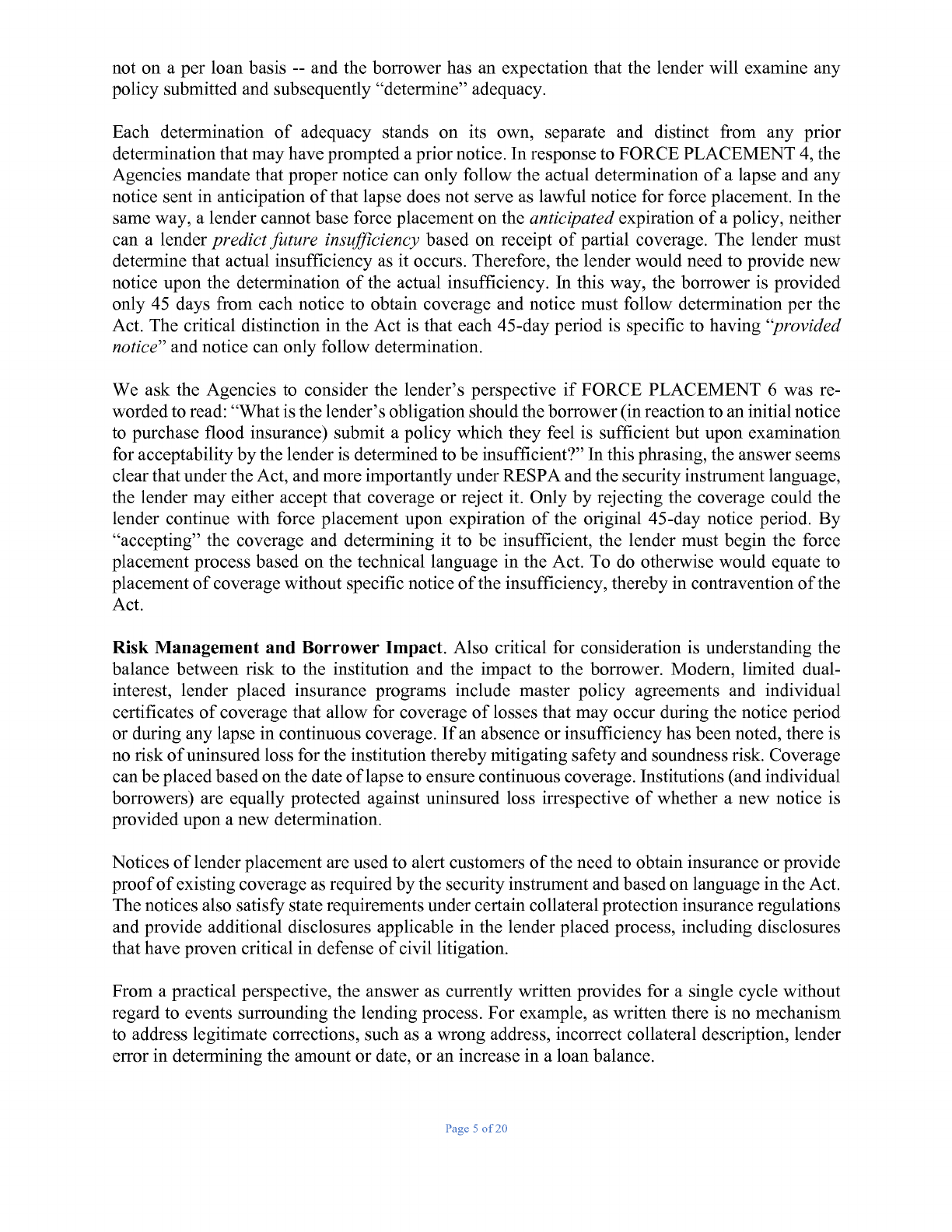
not on a per loan basis
—
and the borrower has an expectation that the lender will examine any
policy submitted and subsequently "determine" adequacy.
Each determination of adequacy stands on its own, separate and distinct from any prior
determination that may have prompted a prior notice. In response to FORCE PLACEMENT 4, the
Agencies mandate that proper notice can only follow the actual determination of a lapse and any
notice sent in anticipation of that lapse does not serve as lawful notice for force placement. In the
same way, a lender cannot base force placement on the anticipated expiration of a policy, neither
can a lender predict future insufficiency based on receipt of partial coverage. The lender must
determine that actual insufficiency as it occurs. Therefore, the lender would need to provide new
notice upon the determination of the actual insufficiency. In this way, the borrower is provided
only 45 days from each notice to obtain coverage and notice must follow determination per the
Act. The critical distinction in the Act is that each 45-day period is specific to having "provided
notice" and notice can only follow determination.
We ask the Agencies to consider the lender's perspective if FORCE PLACEMENT 6 was re
worded to
read:
"What is the lender's obligation should the borrower (in reaction
to
an initial notice
to purchase flood insurance) submit a policy which they feel is sufficient but upon examination
for
acceptability by the lender
is
determined to be
insufficient?"
In this phrasing, the answer seems
clear that under the Act, and more importantly under RESPA and the security instrument language,
the lender may either accept that coverage or reject it. Only by rejecting the coverage could the
lender continue with force placement upon expiration of the original 45-day notice period. By
"accepting" the coverage and determining it to be insufficient, the lender must begin the force
placement process based on the technical language in the Act. To do otherwise would equate to
placement of coverage without specific notice of the
insufficiency,
thereby in contravention of the
Act.
Risk Management and Borrower Impact. Also critical for consideration is understanding the
balance between risk to the institution and the impact to the borrower. Modern, limited dual-
interest, lender placed insurance programs include master policy agreements and individual
certificates of coverage that allow for coverage of losses that may occur during the notice period
or during any lapse in continuous coverage. If an absence or insufficiency has been noted, there is
no risk of uninsured loss for the institution thereby mitigating safety and soundness risk. Coverage
can be placed based on the date of lapse to ensure continuous coverage. Institutions (and individual
borrowers) are equally protected against uninsured loss irrespective of whether a new notice is
provided upon a new determination.
Notices of lender placement are used to alert customers of the need to obtain insurance or provide
proof of existing coverage as required by the security instrument and based on language in the Act.
The notices also
satisfy
state requirements under certain collateral protection insurance regulations
and provide additional disclosures applicable in the lender placed process, including disclosures
that have proven critical in defense of civil litigation.
From a practical perspective, the answer as currently written provides for a single cycle without
regard to events surrounding the lending process. For example, as written there is no mechanism
to address legitimate corrections, such as a wrong address, incorrect collateral description, lender
error in determining the amount or date, or an increase in a loan balance.
-
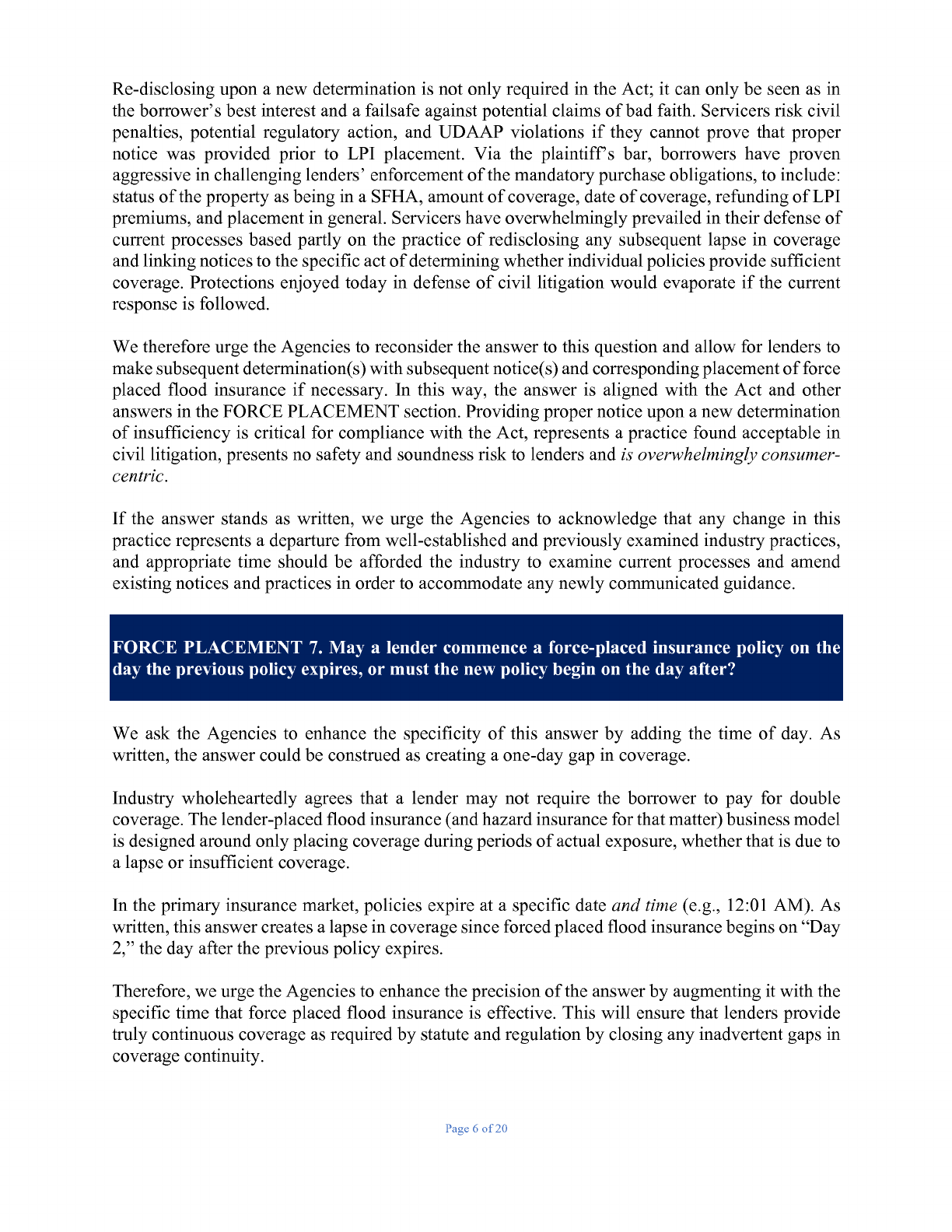
Re-disclosing upon a new determination is not only required in the Act; it can only be seen as in
the borrower's best interest and a
failsafe
against potential claims of bad
faith.
Servicers risk civil
penalties, potential regulatory action, and UDAAP violations if they cannot prove that proper
notice was provided prior to LPI placement. Via the plaintiff's bar, borrowers have proven
aggressive in challenging lenders' enforcement of the mandatory purchase obligations, to include:
status of the property as being in a SFHA, amount of coverage, date of coverage, refunding of LPI
premiums, and placement in general. Servicers have overwhelmingly prevailed in their defense of
current processes based partly on the practice of redisclosing any subsequent lapse in coverage
and linking notices to the specific act of determining whether individual policies provide sufficient
coverage. Protections enjoyed today in defense of civil litigation would evaporate if the current
response is followed.
We therefore urge the Agencies to reconsider the answer to this question and allow for lenders to
make subsequent determination(s) with subsequent notice(s) and corresponding placement of force
placed flood insurance if necessary. In this way, the answer is aligned with the Act and other
answers in the FORCE PLACEMENT section. Providing proper notice upon a new determination
of
insufficiency
is critical for compliance with the Act, represents a practice found acceptable in
civil litigation, presents no safety and soundness risk to lenders and is overwhelmingly consumer-
centric.
If the answer stands as written, we urge the Agencies to acknowledge that any change in this
practice represents a departure from well-established and previously examined industry practices,
and appropriate time should be afforded the industry to examine current processes and amend
existing notices and practices in order to accommodate any newly communicated guidance.
FORCE PLACEMENT 7. May a lender commence a force-placed insurance policy on the
day the previous policy expires, or must the new policy begin on the day after?
We ask the Agencies to enhance the specificity of this answer by adding the time of day. As
written, the answer could be construed as creating a one-day gap in coverage.
Industry wholeheartedly agrees that a lender may not require the borrower to pay for double
coverage. The lender-placed flood insurance (and hazard insurance for that matter) business model
is designed around only placing coverage during periods of actual exposure, whether that is due to
a lapse or insufficient coverage.
In the primary insurance market, policies expire at a specific date and time (e.g., 12:01 AM). As
written, this answer creates
a
lapse in coverage since forced placed flood insurance begins on "Day
2," the day
after
the previous policy expires.
Therefore, we urge the Agencies to enhance the precision of the answer by augmenting it with the
specific time that force placed flood insurance is effective. This will ensure that lenders provide
truly continuous coverage as required by statute and regulation by closing any inadvertent gaps in
coverage continuity.
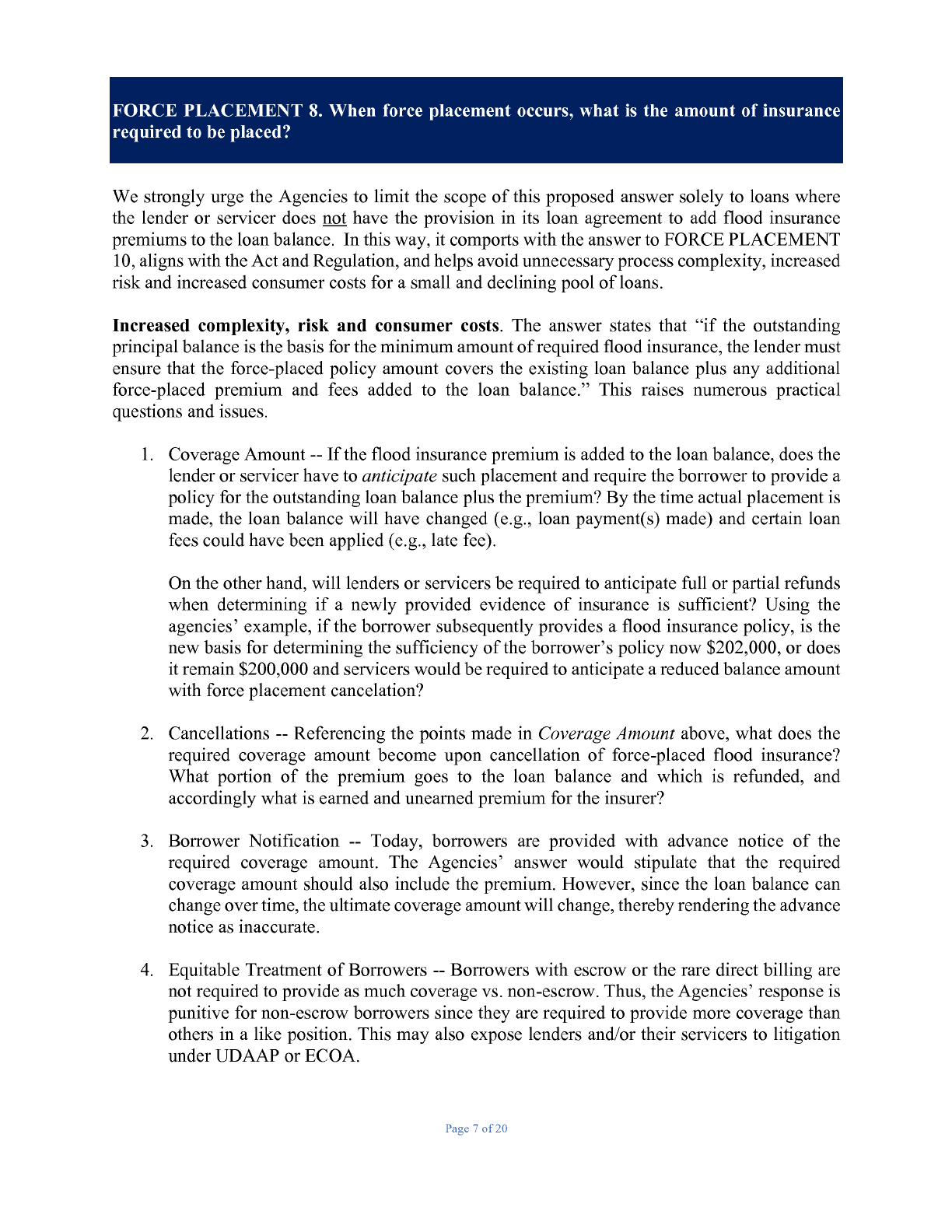
FORCE PLACEMENT 8. When force placement occurs, what is the amount of insurance
required to be placed?
We strongly urge the Agencies to limit the scope of this proposed answer solely to loans where
the lender or servicer does not have the provision in its loan agreement to add flood insurance
premiums to the loan balance. In this way, it comports with the answer to FORCE PLACEMENT
10, aligns with the Act and Regulation, and helps avoid unnecessary process complexity, increased
risk and increased consumer costs for a small and declining pool of loans.
Increased complexity, risk and consumer costs. The answer states that "if the outstanding
principal balance
is
the basis for the minimum amount of required flood insurance, the lender must
ensure that the force-placed policy amount covers the existing loan balance plus any additional
force-placed premium and fees added to the loan balance." This raises numerous practical
questions and issues.
1. Coverage Amount
—
If the flood insurance premium is added to the loan balance, does the
lender or servicer have to anticipate such placement and require the borrower to provide a
policy
for
the outstanding loan balance plus the premium? By the time actual placement is
made, the loan balance will have changed (e.g., loan payment(s) made) and certain loan
fees could have been applied (e.g., late fee).
On the other hand, will lenders or servicers be required to anticipate full or partial refunds
when determining if a newly provided evidence of insurance is sufficient? Using the
agencies' example, if the borrower subsequently provides a flood insurance policy, is the
new basis for determining the sufficiency of the borrower's policy now $202,000, or does
it remain $200,000 and servicers would be required to anticipate
a
reduced balance amount
with force placement cancelation?
2. Cancellations
—
Referencing the points made in Coverage Amount above, what does the
required coverage amount become upon cancellation of force-placed flood insurance?
What portion of the premium goes to the loan balance and which is refunded, and
accordingly what is earned and unearned premium
for
the insurer?
3. Borrower Notification
—
Today, borrowers are provided with advance notice of the
required coverage amount. The Agencies' answer would stipulate that the required
coverage amount should also include the premium. However, since the loan balance can
change over time, the ultimate coverage amount will change, thereby rendering the advance
notice as inaccurate.
4. Equitable Treatment of Borrowers
—
Borrowers with escrow or the rare direct billing are
not required to provide as much coverage vs. non-escrow. Thus, the Agencies' response is
punitive for non-escrow borrowers since they are required to provide more coverage than
others in a like position. This may also expose lenders and/or their servicers to litigation
under UDAAP or ECOA.

5. Insurance Theory
—
Including the premium in the limit of coverage - the principal loan
balance
-
is an invalid insurance structure in that the benefit
(i.e.,
the principal loan balance)
cannot be structured as paying for
itself.
The premium, while technically added to the loan
balance, is a separate and distinct purchase that affords value as part of the lender's risk
management system.
6. Data Processing — This requirement introduces a recursive mathematical premium
function, unknown cancellation logic and new loan tracking and reporting requirements.
This functionality does not exist today in financial institution accounting systems, thereby
raising complexity and costs that will be passed on to all borrowers.
In addition to these significant practical issues, the requirement of mandatory escrow at the time
of a MIRE event codified in the Biggert-Waters Flood Insurance Reform Act means these
requirements apply to a small and declining pool of loans nationwide. The complexity and cost
increases would be disproportionate to the benefits gained from such a requirement.
Alignment with FORCE PLACEMENT 10. This response is in conflict with the answer to
FORCE PLACEMENT 10, where the Agencies state that if the loan contract allows for the
addition of flood insurance premiums to the loan balance, it
is
not an "increase" in the loan amount:
"If the lender's loan contract with the borrower includes a provision permitting the lender
or servicer to advance funds to pay for flood insurance premiums and fees as additional
debt to be secured by the building or mobile home, such an advancement would be
considered part of the loan. As such, the addition of the flood insurance premiums and fees
to the loan balance is not considered an "increase" in the loan amount..."
While the answer above is part of describing the methods of paying for premiums and whether
each method constitutes a triggering event for the lender to determine the sufficiency of flood
insurance coverage on the loan, this very same logic should flow through to the basis
for
premium
calculation as well. That is, if the Agencies stipulate in FORCE PLACEMENT 10 that the loan
balance is not "increased" when flood insurance is added to a loan that contractually allows for
such an addition of premium, then the basis for flood insurance premium should follow the same
logic and be defined as solely the principal loan balance
—
without the addition of the flood
insurance premium.
Alignment with the Act and Regulation. This answer accurately states that the minimum amount
of flood insurance required must be at least equal to the lesser of the outstanding principal balance
of the designated loan or the maximum limit of coverage available for the particular type of
property under the Act (emphasis added). However, outstanding principal balance is a term applied
throughout the Act and Regulation and therefore has special meaning. The outstanding principal
balance of a loan does not refer to fees, advances, or other charges which are not considered part
of the principal and are treated differently for accounting purposes. Many lenders establish and
maintain a separate account(s) to hold force-placed premiums, foreclosure fees, property
preservation fees, late fees, inspection costs, and other charges due under the contractual loan
agreement and securitized by the property but not considered part of the "principal balance." The
drafters could not have contemplated including flood insurance premiums in the definition of
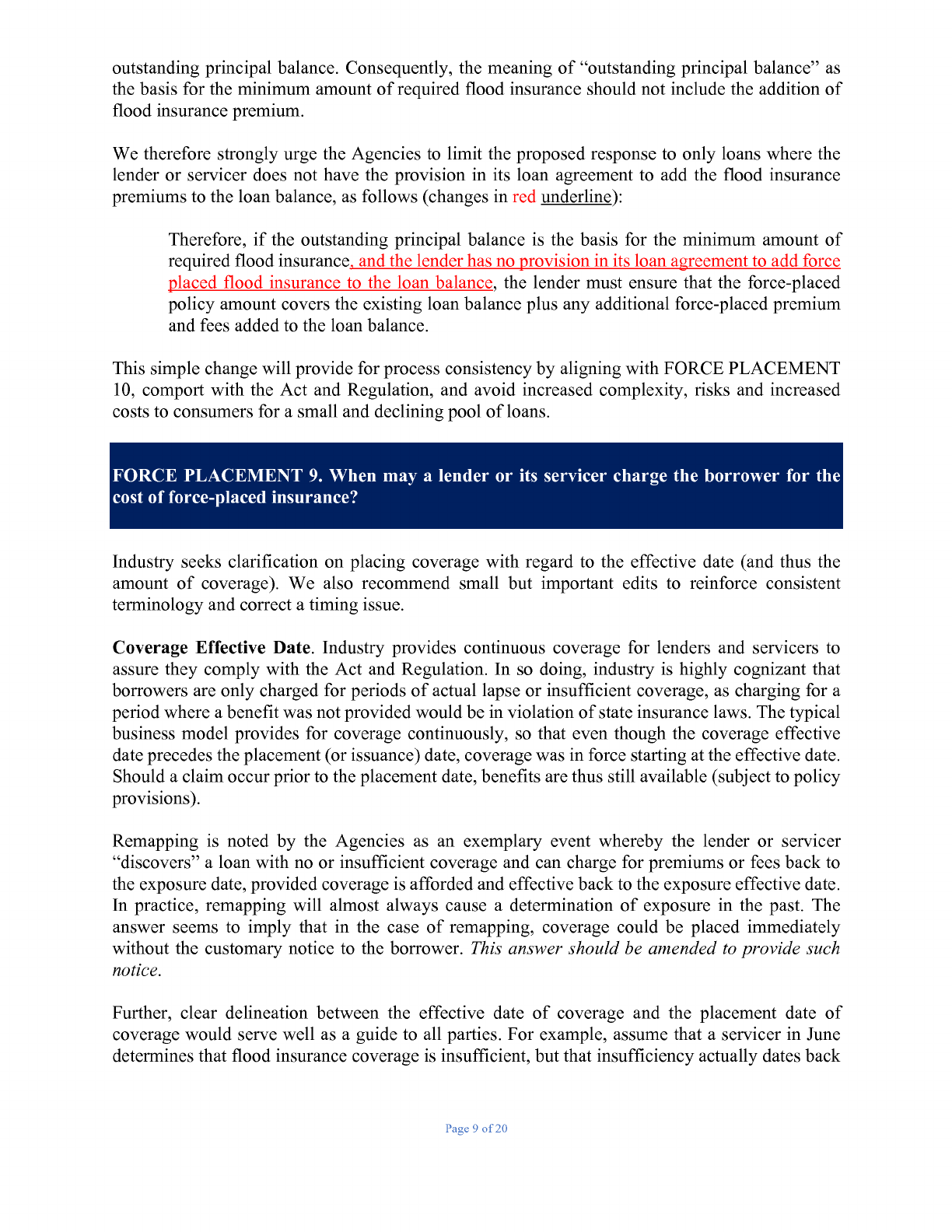
outstanding principal balance. Consequently, the meaning of "outstanding principal balance" as
the basis for the minimum amount of required flood insurance should not include the addition of
flood insurance premium.
We therefore strongly urge the Agencies to limit the proposed response to only loans where the
lender or servicer does not have the provision in its loan agreement to add the flood insurance
premiums to the loan balance, as follows (changes in red underline):
Therefore, if the outstanding principal balance is the basis for the minimum amount of
required flood insurance, and the lender has no provision in its loan agreement to add force
placed flood insurance to the loan balance, the lender must ensure that the force-placed
policy amount covers the existing loan balance plus any additional force-placed premium
and fees added to the loan balance.
This simple change will provide
for
process consistency by aligning with FORCE PLACEMENT
10, comport with the Act and Regulation, and avoid increased complexity, risks and increased
costs to consumers for a small and declining pool of loans.
FORCE PLACEMENT 9. When may a lender or its servicer charge the borrower for the
cost of force-placed insurance?
Industry seeks clarification on placing coverage with regard to the effective date (and thus the
amount of coverage). We also recommend small but important edits to reinforce consistent
terminology and correct a timing issue.
Coverage Effective Date. Industry provides continuous coverage for lenders and servicers to
assure they comply with the Act and Regulation. In so doing, industry is highly cognizant that
borrowers are only charged for periods of actual lapse or insufficient coverage, as charging for a
period where
a
benefit was not provided would be in violation of state insurance laws. The typical
business model provides for coverage continuously, so that even though the coverage effective
date precedes the placement (or issuance) date, coverage was in
force
starting at the
effective
date.
Should a claim occur prior
to
the placement date, benefits are thus still available (subject to policy
provisions).
Remapping is noted by the Agencies as an exemplary event whereby the lender or servicer
"discovers" a loan with no or insufficient coverage and can charge for premiums or fees back to
the exposure date, provided coverage is afforded and
effective
back to the exposure
effective
date.
In practice, remapping will almost always cause a determination of exposure in the past. The
answer seems to imply that in the case of remapping, coverage could be placed immediately
without the customary notice to the borrower. This answer should be amended to provide such
notice.
Further, clear delineation between the effective date of coverage and the placement date of
coverage would serve well as a guide to all parties. For example, assume that a servicer in June
determines that flood insurance coverage is
insufficient,
but that insufficiency actually dates back
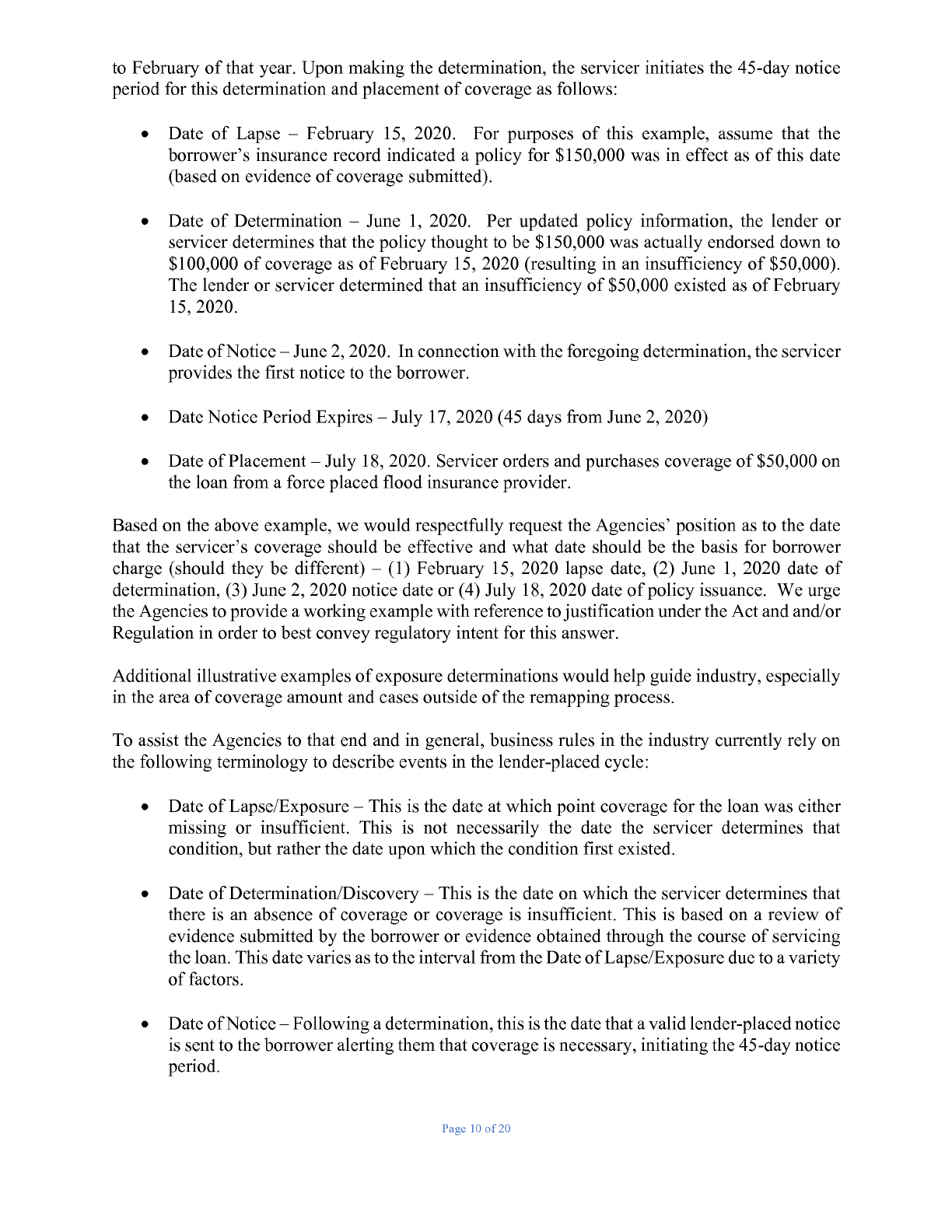
to February of that year. Upon making the determination, the servicer initiates the 45-day notice
period for this determination and placement of coverage as follows:
• Date of Lapse - February 15, 2020. For purposes of this example, assume that the
borrower's insurance record indicated a policy for $150,000 was in effect as of this date
(based on evidence of coverage submitted).
• Date of Determination - June 1, 2020. Per updated policy information, the lender or
servicer determines that the policy thought to be $150,000 was actually endorsed down to
$100,000 of coverage as of February 15, 2020 (resulting in an insufficiency of $50,000).
The lender or servicer determined that an insufficiency of $50,000 existed as of February
15, 2020.
• Date of Notice - June
2,
2020. In connection with the foregoing determination, the servicer
provides the first notice to the borrower.
• Date Notice Period Expires - July 17, 2020 (45 days from June 2, 2020)
• Date of Placement - July 18, 2020. Servicer orders and purchases coverage of $50,000 on
the loan from a
force
placed flood insurance provider.
Based on the above example, we would respectfully request the Agencies' position as to the date
that the servicer's coverage should be effective and what date should be the basis for borrower
charge (should they be different) - (1) February 15, 2020 lapse date, (2) June 1, 2020 date of
determination, (3) June 2, 2020 notice date or (4) July 18, 2020 date of policy issuance. We urge
the Agencies to provide a working example with reference to justification under the Act and and/or
Regulation in order to best convey regulatory intent
for
this answer.
Additional illustrative examples of exposure determinations would help guide industry, especially
in the area of coverage amount and cases outside of the remapping process.
To assist the Agencies to that end and in general, business rules in the industry currently rely on
the following terminology to describe events in the lender-placed cycle:
• Date of Lapse/Exposure - This is the date at which point coverage for the loan was either
missing or insufficient. This is not necessarily the date the servicer determines that
condition, but rather the date upon which the condition first existed.
• Date of Determination/Discovery - This is the date on which the servicer determines that
there is an absence of coverage or coverage is insufficient. This is based on a review of
evidence submitted by the borrower or evidence obtained through the course of servicing
the loan. This date varies as to the interval from the Date of Lapse/Exposure due to a variety
of factors.
• Date of Notice - Following
a
determination, this is the date that a valid lender-placed notice
is sent to the borrower alerting them that coverage is necessary, initiating the 45-day notice
period.

• Date Notice Period Expires - This is the date ending 45-days after the date a valid notice
was provided to the borrower. This date marks the conclusion of the "notice period" or the
period where the borrower is
afforded
time to obtain their own policy.
• Date of Placement/Issuance - This is the date a lender-placed policy is obtained by the
servicer. This marks the date the policy is ordered by the servicer and the loan servicing
system reflects that coverage has been procured. Note that this is not 100% analogous to
the date the LPI policy is printed and mailed to the borrower; that date may occur after
processing by the lender-placed vendor.
• Effective Date of Coverage - This is the date upon which coverage under the policy
becomes, or became, effective. Coverage afforded through the policy begins on this date.
This date determines the premium due.
• Date Borrower is Assessed a Charge - This is the date where a charge is made, typically
an escrow account is established or assessed
for
premiums due once the policy is procured
by the servicer.
Determination of
a
past exposure raises questions regarding how to establish the amount and term
of coverage (i.e., how much coverage and how far back). We would ask that the Agencies provide
additional guidance in this regard through clarification and examples. Barring such guidance,
industry will continue to assure lenders and/or their servicers have continuous coverage available
to mitigate lending risk.
Terminology and Timing. Noted at the outset, throughout the Interagency Q&A, we suggest
using the term "determine" in lieu of "discover" or other similar terms. For this answer, we
recommend the following edit (shown in red underline):
If a lender or its servicer, despite its monitoring efforts, discovers determines that a loan with
has no or insufficient coverage, for example, due to a re-mapping...
This helps reinforce the desired process pattern of "determine" "notice" "placement" for
force-placed flood insurance.
In the very last sentence of this answer, the Agencies stipulate that "...the lender or its servicer
may not charge for premiums and fees for coverage beginning on the date of lapse or insufficient
coverage if that policy purchased on the borrower's behalf did not provide coverage for the
borrower prior to purchase." It is important to note that outside of the Agencies' guidance, state
insurance law strictly prohibits charging for coverage where no benefit exists.
Since the coverage amount and term are not known until coverage is actually purchased, we offer
the following change (shown in red underline) : "...borrower's behalf does did not..."
Industry
offers
two small but important edits to address terminology and timing, and importantly,
respectfully seeks clarification on the coverage effective date and additional guidance via
illustrative examples rooted in the Act and/or the Regulation.
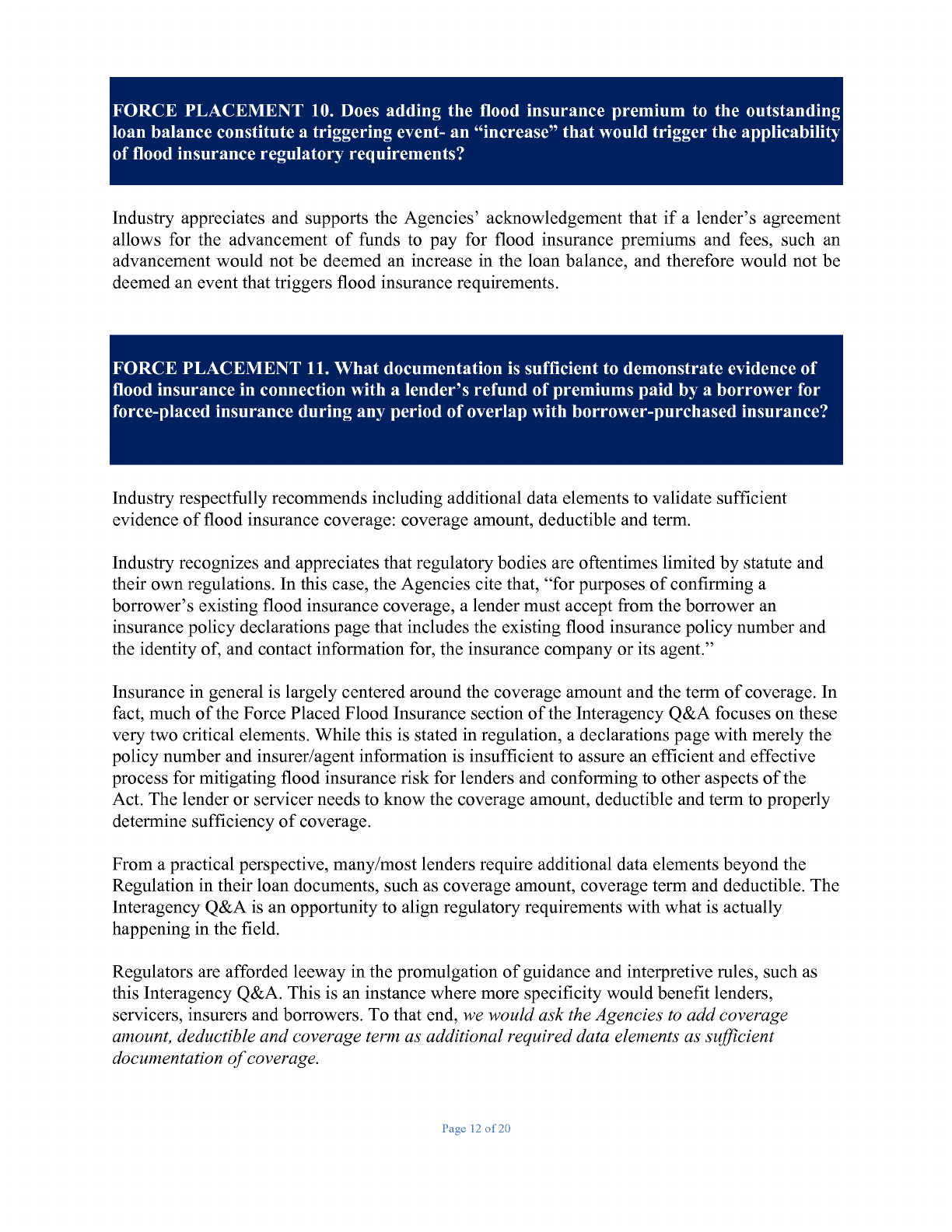
FORCE PLACEMENT 10. Does adding the flood insurance premium to the outstanding
loan balance constitute a triggering event- an "increase" that would trigger the applicability
of
flood
insurance regulatory requirements?
Industry appreciates and supports the Agencies' acknowledgement that if a lender's agreement
allows for the advancement of funds to pay for flood insurance premiums and fees, such an
advancement would not be deemed an increase in the loan balance, and therefore would not be
deemed an event that triggers flood insurance requirements.
FORCE PLACEMENT 11. What documentation is sufficient to demonstrate evidence of
flood insurance in connection with a lender's refund of premiums paid by a borrower for
force-placed insurance during any period of overlap with borrower-purchased insurance?
Industry respectfully recommends including additional data elements to validate sufficient
evidence of flood insurance coverage: coverage amount, deductible and term.
Industry recognizes and appreciates that regulatory bodies are oftentimes limited by statute and
their own regulations. In this case, the Agencies cite that, "for purposes of confirming a
borrower's existing flood insurance coverage, a lender must accept
from
the borrower an
insurance policy declarations page that includes the existing flood insurance policy number and
the identity
of,
and contact information for, the insurance company or its agent."
Insurance in general is largely centered around the coverage amount and the term of coverage. In
fact, much of the Force Placed Flood Insurance section of the Interagency Q&A focuses on these
very two critical elements. While this is stated in regulation, a declarations page with merely the
policy number and insurer/agent information is insufficient to assure an efficient and effective
process for mitigating flood insurance risk for lenders and conforming to other aspects of the
Act. The lender or servicer needs to know the coverage amount, deductible and term to properly
determine sufficiency of coverage.
From a practical perspective, many/most lenders require additional data elements beyond the
Regulation in their loan documents, such as coverage amount, coverage term and deductible. The
Interagency Q&A is an opportunity to align regulatory requirements with what is actually
happening in the field.
Regulators are afforded leeway in the promulgation of guidance and interpretive rules, such as
this Interagency Q&A. This is an instance where more specificity would benefit lenders,
servicers, insurers and borrowers. To that end, we would ask the Agencies to add coverage
amount, deductible and coverage term as additional required data elements as sufficient
documentation of coverage.
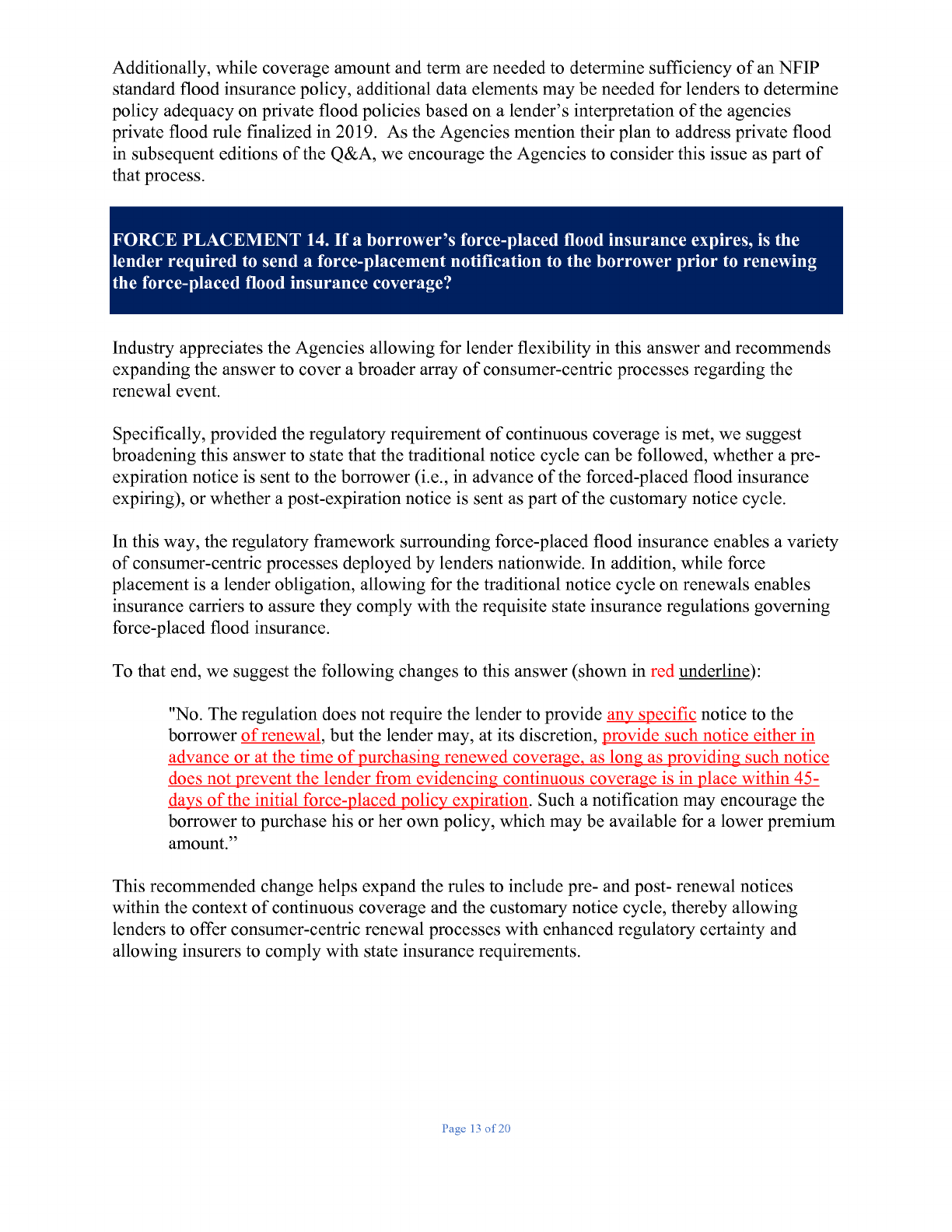
Additionally, while coverage amount and term are needed to determine sufficiency of an NFIP
standard flood insurance policy, additional data elements may be needed for lenders to determine
policy adequacy on private flood policies based on a lender's interpretation of the agencies
private flood rule finalized in 2019. As the Agencies mention their plan to address private flood
in subsequent editions of the Q&A, we encourage the Agencies to consider this issue as part of
that process.
FORCE PLACEMENT 14. If
a
borrower's force-placed flood insurance expires, is the
lender required to send a force-placement notification to the borrower prior to renewing
the force-placed flood insurance coverage?
Industry appreciates the Agencies allowing for lender flexibility in this answer and recommends
expanding the answer to cover a broader array of consumer-centric processes regarding the
renewal event.
Specifically, provided the regulatory requirement of continuous coverage is met, we suggest
broadening this answer to state that the traditional notice cycle can be followed, whether
a
pre
expiration notice is sent to the borrower (i.e., in advance of the forced-placed flood insurance
expiring), or whether a post-expiration notice is sent as part of the customary notice cycle.
In this way, the regulatory framework surrounding force-placed flood insurance enables a variety
of consumer-centric processes deployed by lenders nationwide. In addition, while force
placement is a lender obligation, allowing
for
the traditional notice cycle on renewals enables
insurance carriers to assure they comply with the requisite state insurance regulations governing
force-placed flood insurance.
To that end, we suggest the following changes to this answer (shown in red underline):
"No. The regulation does not require the lender to provide any specific notice to the
borrower of renewal, but the lender may, at its discretion, provide such notice either in
advance or at the time of purchasing renewed coverage, as long as providing such notice
does not prevent the lender from evidencing continuous coverage is in place within 45
days of the initial force-placed policy expiration. Such a notification may encourage the
borrower to purchase his or her own policy, which may be available for a lower premium
amount."
This recommended change helps expand the rules to include pre- and post- renewal notices
within the context of continuous coverage and the customary notice cycle, thereby allowing
lenders to offer consumer-centric renewal processes with enhanced regulatory certainty and
allowing insurers to comply with state insurance requirements.
-
-
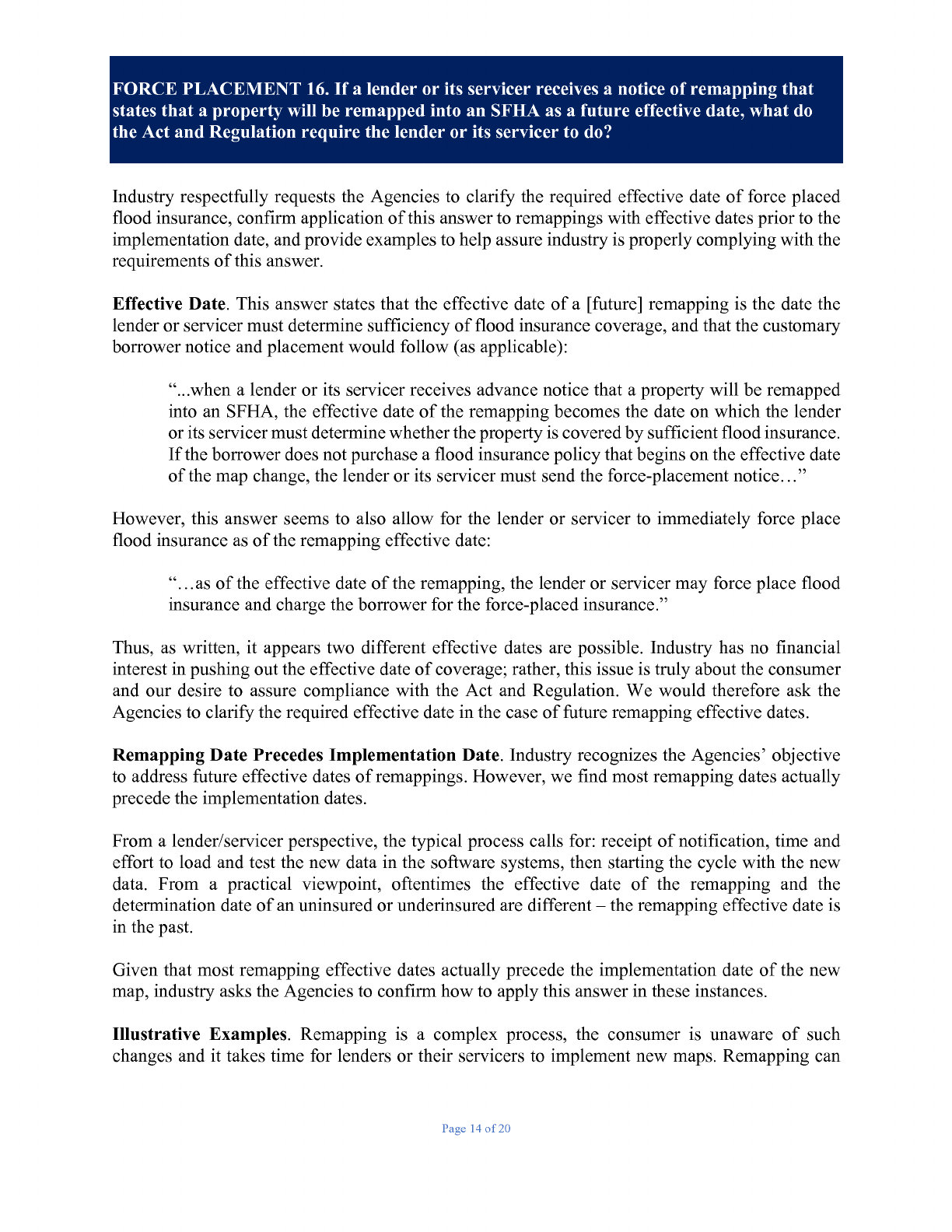
FORCE PLACEMENT 16. If
a
lender or its servicer receives a notice of remapping that
states that a property will be remapped into an SFHA as a future effective date, what do
the Act and Regulation require the lender or its servicer to do?
Industry respectfully requests the Agencies to clarify the required effective date of
force
placed
flood insurance, confirm application of this answer to remappings with
effective
dates prior to the
implementation date, and provide examples to help assure industry is properly complying with the
requirements of this answer.
Effective Date. This answer states that the effective date of a [future] remapping is the date the
lender or servicer must determine
sufficiency
of flood insurance coverage, and that the customary
borrower notice and placement would follow (as applicable):
"...when a lender or its servicer receives advance notice that a property will be remapped
into an SFHA, the effective date of the remapping becomes the date on which the lender
or
its
servicer must determine whether the property
is
covered by
sufficient
flood insurance.
If the borrower does not purchase a flood insurance policy that begins on the effective date
of the map change, the lender or its servicer must send the force-placement notice..."
However, this answer seems to also allow for the lender or servicer to immediately force place
flood insurance as of the remapping effective date:
"...as of the effective date of the remapping, the lender or servicer may force place flood
insurance and charge the borrower
for
the force-placed insurance."
Thus, as written, it appears two different effective dates are possible. Industry has no financial
interest in pushing out the effective date of coverage; rather, this issue is truly about the consumer
and our desire to assure compliance with the Act and Regulation. We would therefore ask the
Agencies to
clarify
the required effective date in the case of future remapping effective dates.
Remapping Date Precedes Implementation Date. Industry recognizes the Agencies' objective
to address future effective dates of remappings. However, we find most remapping dates actually
precede the implementation dates.
From a lender/servicer perspective, the typical process calls for: receipt of notification, time and
effort to load and test the new data in the software systems, then starting the cycle with the new
data. From a practical viewpoint, oftentimes the effective date of the remapping and the
determination date of an uninsured or underinsured are
different
- the remapping effective date is
in the past.
Given that most remapping effective dates actually precede the implementation date of the new
map, industry asks the Agencies to confirm how to apply this answer in these instances.
Illustrative Examples. Remapping is a complex process, the consumer is unaware of such
changes and it takes time for lenders or their servicers to implement new maps. Remapping can

create different situations that may result in different requirements, or at the very least shed new
light for all parties. Given the complexity of this matter, we urge the Agencies demonstrate the
proposed requirements with a series of illustrative examples.
Coupling the examples with a clarification on the
effective
date of coverage and a confirmation of
this answer's applicability to remapping dates that precede implementation dates will serve as a
clear guide to help assure industry effectively and efficiently complies with the Act and
Regulation.
ESCROW 3. Are lenders required to escrow force-placed insurance?
Industry recommends a change to this answer to align with the proposed answer to FORCE
PLACEMENT 10. Industry also seeks additional guidance on when the escrow requirement
would become effective in the event of force-placement.
ESCROW
3
requires "lenders or their servicers to escrow flood insurance premiums for any
residential designated loan made, increased, extended, or renewed [a "MIRE" event] on or after
January 1, 2016, unless the lender or the loan qualifies for an exception from the escrow
requirement. The Act and Regulation do not include an exception to the escrow requirement for
force-placed insurance."
Industry appreciates that this question and answer is presented to avoid ambiguity on how the
escrow requirement applies to force-placed flood insurance. However, as currently written, the
proposed answer suggests that all force-placement of flood insurance premium would trigger the
escrow requirement, which does not align with the proposed answer to FORCE PLACEMENT
10.
FORCE PLACEMENT 10 states that adding flood insurance premiums to the loan balance is not
considered a MIRE event - thus not an escrow-triggering event per ESCROW
1
and
3 —
if the
loan agreement "includes a provision permitting the lender or servicer to advance
funds
to pay
for flood insurance premiums and fees as additional debt to be secured by the building or mobile
home."
To avoid ambiguity and resolve the dissonance in the proposed answers, industry proposes a
revision of the last sentence in this answer to read as follows (change shown in red underline):
The Act and Regulation do not include an exception to the escrow requirement for force-
placed flood insurance if the purchase by the lender of force placed flood insurance
results in a MIRE event pursuant to Q&A FORCE PLACEMENT 10.
With this change, the answer to ESCROW
3
provides an exception
for
the addition of flood
insurance premiums to the loan balance where the loan agreement provides for such an advance,
thereby providing consistency between this answer and FORCE PLACEMENT 10.

Additionally, industry is seeking guidance on when the escrow requirement would begin in the
event the lender or servicer adds force-placement premiums to the loan balance and the loan
documents do not provide for such advances (i.e. an "increase" according to FORCE
PLACEMENT 10). If the escrow requirement is triggered upon increasing the loan balance, the
lender is required to escrow force-placed premiums, but that is not possible because the
premiums were already added to the loan balance. The force-placed flood insurance premiums
cannot be both added to the loan balance and escrowed at the same time.
Therefore, the industry respectfully asks the Agencies to provide guidance on how the escrow
requirement would need to be implemented in instances that a lender or servicer adds force-placed
insurance premiums to the loan balance, but the loan documents do not provide for such advances.
ZONE 1. What should a lender do when there is a discrepancy between the flood hazard
zone designation on the flood determination form and the flood insurance policy?
Industry supports the Agencies' change in position in this answer which no longer requires the
lender to reconcile a policy declarations page that has a flood zone designation that is different
from
the flood zone shown on the Special Flood Hazard Determination Form ("SFHDF"). We
also respectfully request that the Agencies apply this answer to the entire loan cycle, to amend its
position on initiating the
force
placement process during claim handling if a homeowner does not
pay the additional premium to reform the NFIP flood insurance policy.
Application throughout the loan. In its answer, the Agencies state that "This guidance applies
to any flood zone discrepancy that arises in connection with a mortgage loan that is made,
increased, extended or renewed" (i.e., a "MIRE" event).
Industry observes that such a discrepancy can occur outside of a MIRE event, such as with a
simple renewal of a flood insurance policy, a replacement flood insurance policy, and/or a
remapping event. That is, there are ongoing events outside of a pure MIRE event where a lender
may discover a discrepancy.
To assure this important change applies comprehensively in scope, industry recommends adding
the following
—
or something quite similar
—
to the current answer (change shown in red
underline):
"This guidance applies to any flood zone discrepancy that arises in connection with a
mortgage loan that is made, increased, extended or renewed, or throughout the life of the
loan."
Treatment of Misratings. This answer could be interpreted that the Agencies are suggesting
that force-placement is appropriate during the claim handling process to address a premium
deficiency. For numerous reasons, we urge the Agencies to reconsider amending this answer.
First, while relieved of the requirement to reconcile a policy declarations page that has a flood
zone designation that is different
from
the flood zone shown on the SFHDF, industry believes it
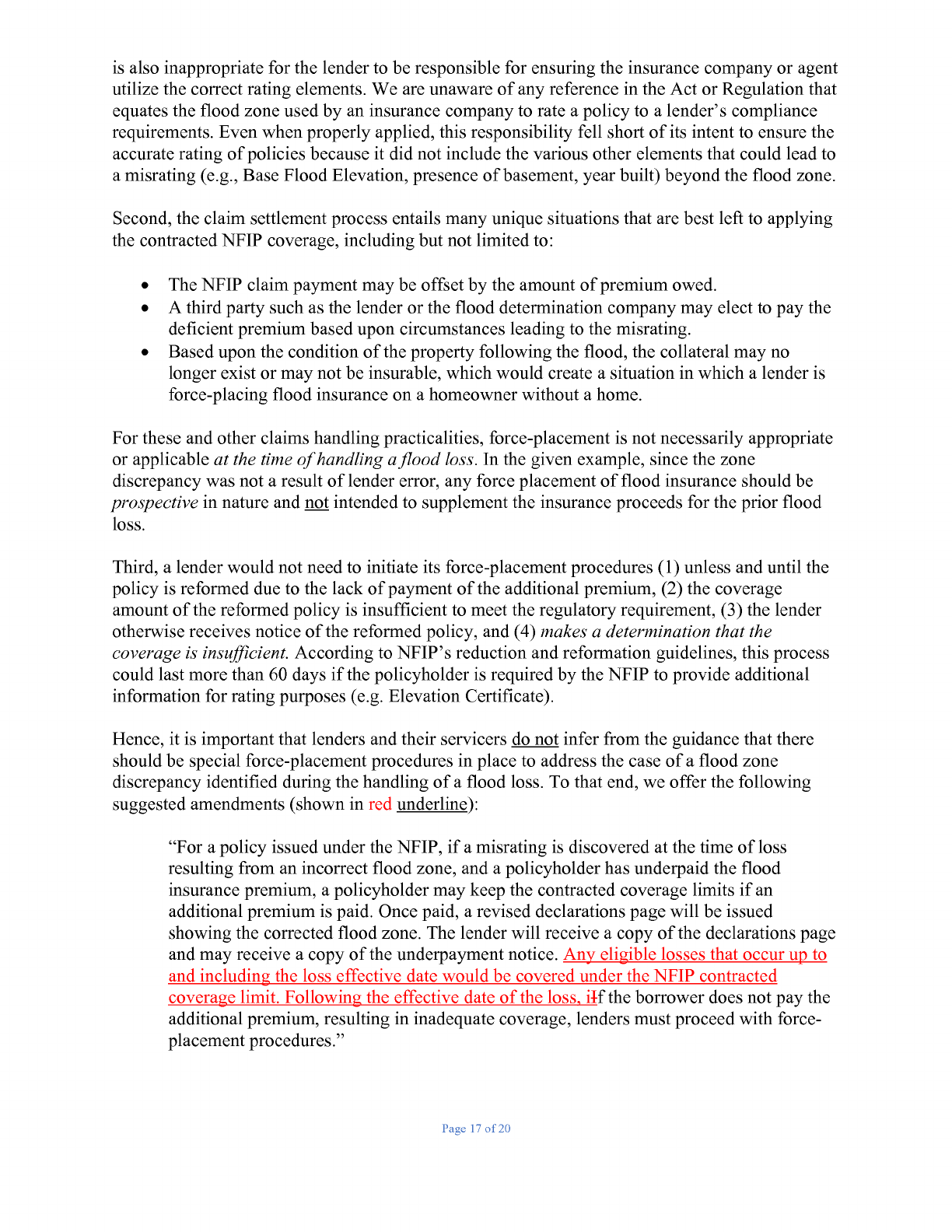
is also inappropriate
for
the lender to be responsible for ensuring the insurance company or agent
utilize the correct rating elements. We are unaware of any reference in the Act or Regulation that
equates the flood zone used by an insurance company to rate a policy to a lender's compliance
requirements. Even when properly applied, this responsibility fell short of its intent to ensure the
accurate rating of policies because it did not include the various other elements that could lead to
a misrating (e.g., Base Flood Elevation, presence of basement, year built) beyond the flood zone.
Second, the claim settlement process entails many unique situations that are best left to applying
the contracted NFIP coverage, including but not limited to:
• The NFIP claim payment may be
offset
by the amount of premium owed.
• A third party such as the lender or the flood determination company may elect to pay the
deficient premium based upon circumstances leading to the misrating.
• Based upon the condition of the property following the flood, the collateral may no
longer exist or may not be insurable, which would create a situation in which a lender is
force-placing flood insurance on a homeowner without a home.
For these and other claims handling practicalities, force-placement is not necessarily appropriate
or applicable at the time of handling a flood loss. In the given example, since the zone
discrepancy was not a result of lender error, any
force
placement of flood insurance should be
prospective in nature and not intended to supplement the insurance proceeds
for
the prior flood
loss.
Third, a lender would not need to initiate its force-placement procedures (1) unless and until the
policy is reformed due to the lack of payment of the additional premium, (2) the coverage
amount of the reformed policy is insufficient to meet the regulatory requirement, (3) the lender
otherwise receives notice of the reformed policy, and (4) makes a determination that the
coverage is insufficient. According to NFIP's reduction and reformation guidelines, this process
could last more than 60 days if the policyholder is required by the NFIP to provide additional
information for rating purposes (e.g. Elevation Certificate).
Hence, it is important that lenders and their servicers do not infer
from
the guidance that there
should be special force-placement procedures in place to address the case of a flood zone
discrepancy identified during the handling of a flood loss. To that end, we
offer
the following
suggested amendments (shown in red underline):
"For
a
policy issued under the NFIP, if a misrating is discovered at the time of loss
resulting from an incorrect flood zone, and a policyholder has underpaid the flood
insurance premium, a policyholder may keep the contracted coverage limits if an
additional premium is paid. Once paid, a revised declarations page will be issued
showing the corrected flood zone. The lender will receive a copy of the declarations page
and may receive a copy of the underpayment notice. Any eligible losses that occur up to
coverage limit. Following the effective date of the loss, i
and including the loss effective date would be covered under the NFIP contracted
If the borrower does not pay the
additional premium, resulting in inadequate coverage, lenders must proceed with force-
placement procedures."
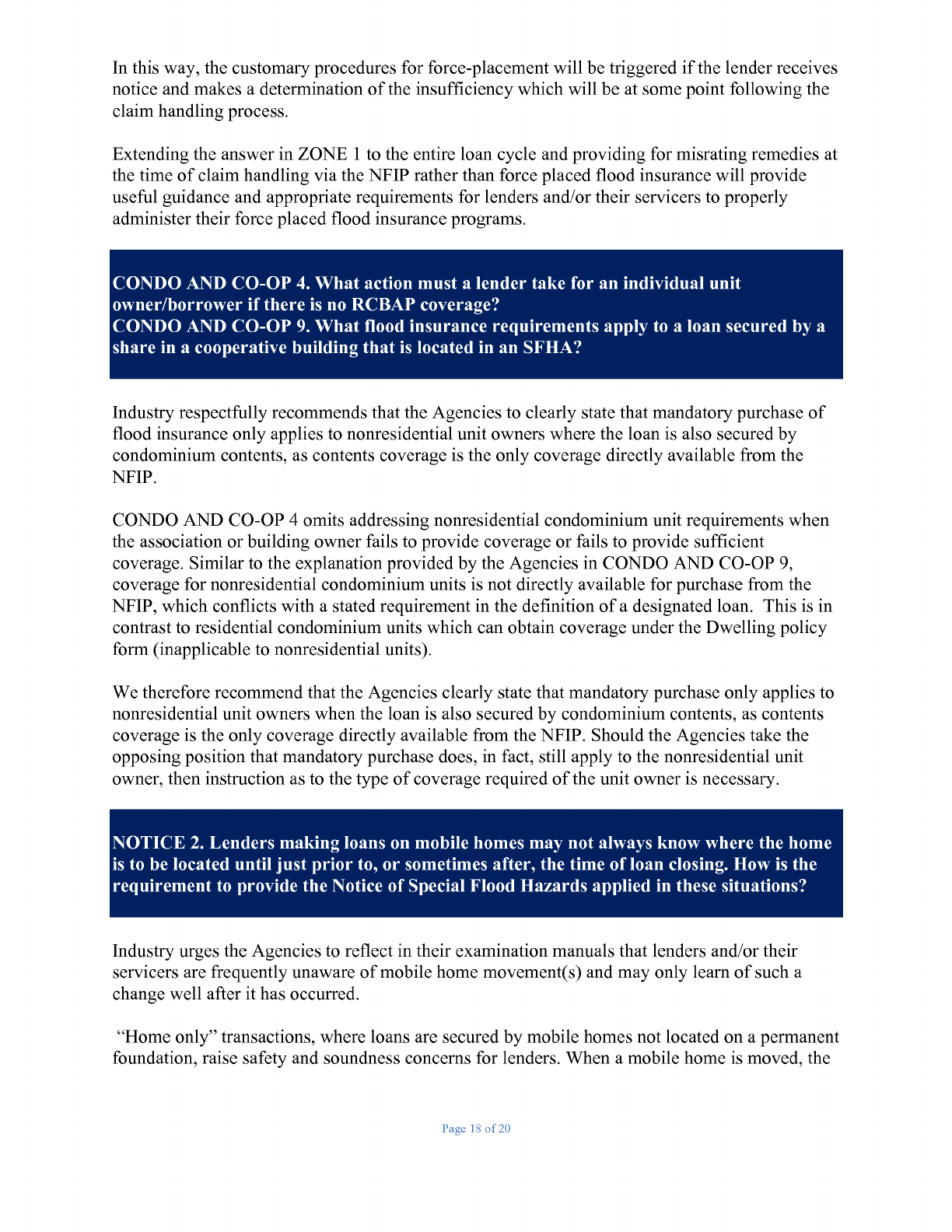
In this way, the customary procedures for force-placement will be triggered if the lender receives
notice and makes a determination of the
insufficiency
which will be at some point following the
claim handling process.
Extending the answer in ZONE
1
to the entire loan cycle and providing for misrating remedies at
the time of claim handling via the NFIP rather than
force
placed flood insurance will provide
useful guidance and appropriate requirements for lenders and/or their servicers to properly
administer their
force
placed flood insurance programs.
CONDO AND CO-OP 4. What action must a lender take for an individual unit
owner/borrower if there is no RCBAP coverage?
CONDO AND CO-OP 9. What flood insurance requirements apply to a loan secured by a
share in a cooperative building that is located in an SFHA?
Industry respectfully recommends that the Agencies to clearly state that mandatory purchase of
flood insurance only applies to nonresidential unit owners where the loan is also secured by
condominium contents, as contents coverage is the only coverage directly available
from
the
NFIP.
CONDO AND CO-OP 4 omits addressing nonresidential condominium unit requirements when
the association or building owner fails to provide coverage or
fails
to provide sufficient
coverage. Similar to the explanation provided by the Agencies in CONDO AND CO-OP 9,
coverage for nonresidential condominium units is not directly available
for
purchase from the
NFIP, which conflicts with a stated requirement in the definition of a designated loan. This is in
contrast to residential condominium units which can obtain coverage under the Dwelling policy
form (inapplicable to nonresidential units).
We therefore recommend that the Agencies clearly state that mandatory purchase only applies to
nonresidential unit owners when the loan is also secured by condominium contents, as contents
coverage is the only coverage directly available from the NFIP. Should the Agencies take the
opposing position that mandatory purchase does, in fact, still apply to the nonresidential unit
owner, then instruction as to the type of coverage required of the unit owner is necessary.
NOTICE 2. Lenders making loans on mobile homes may not always know where the home
is to be located until just prior to, or sometimes after, the time of loan closing. How is the
requirement to provide the Notice of Special Flood Hazards applied in these situations?
Industry urges the Agencies to reflect in their examination manuals that lenders and/or their
servicers are frequently unaware of mobile home movement(s) and may only learn of such a
change well after it has occurred.
"Home only" transactions, where loans are secured by mobile homes not located on a permanent
foundation, raise safety and soundness concerns for lenders. When a mobile home is moved, the
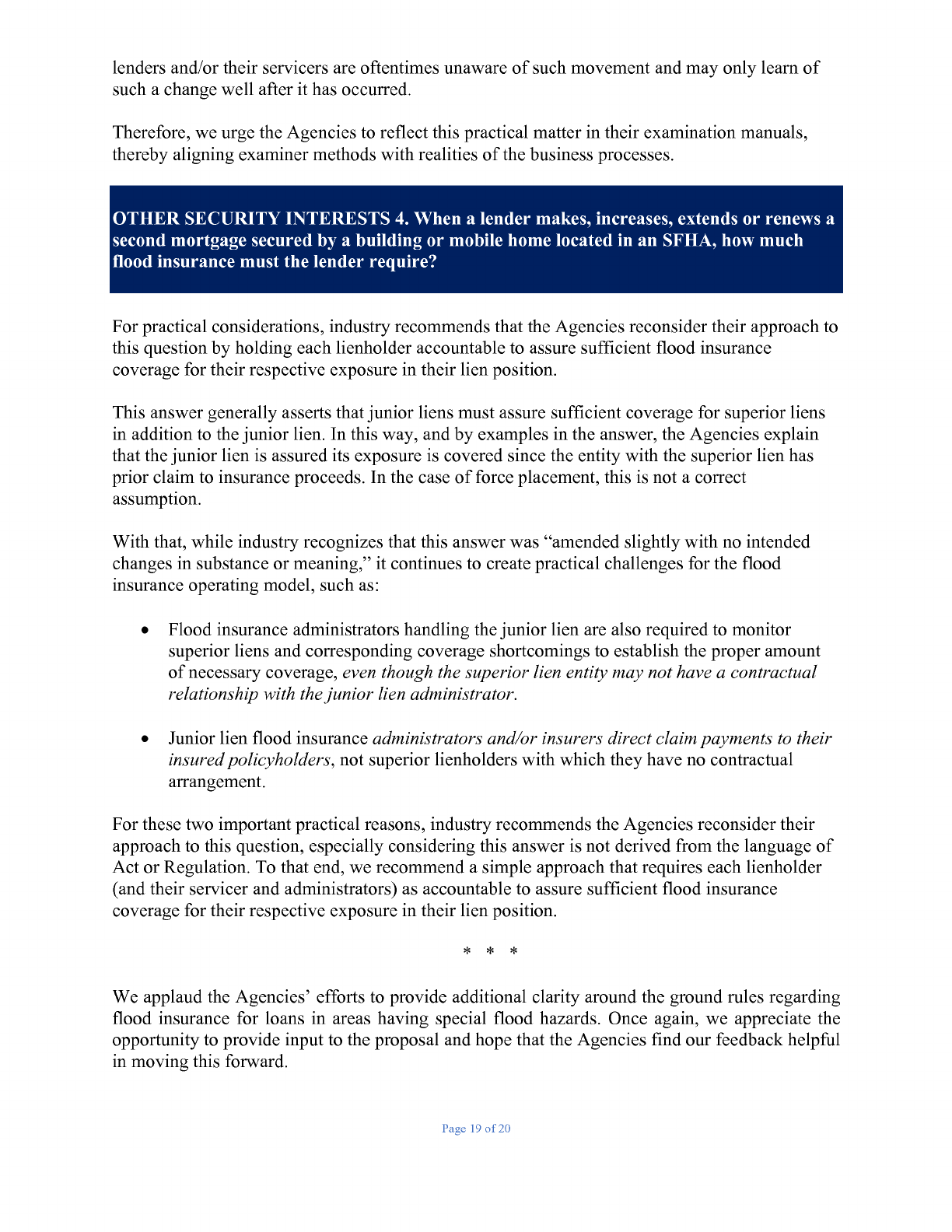
lenders and/or their servicers are oftentimes unaware of such movement and may only learn of
such a change well after it has occurred.
Therefore, we urge the Agencies to reflect this practical matter in their examination manuals,
thereby aligning examiner methods with realities of the business processes.
OTHER SECURITY INTERESTS 4. When a lender makes, increases, extends or renews a
second mortgage secured by a building or mobile home located in an SFHA, how much
flood insurance must the lender require?
For practical considerations, industry recommends that the Agencies reconsider their approach to
this question by holding each lienholder accountable to assure sufficient flood insurance
coverage
for
their respective exposure in their lien position.
This answer generally asserts that junior liens must assure sufficient coverage for superior liens
in addition to the junior lien. In this way, and by examples in the answer, the Agencies explain
that the junior lien is assured its exposure is covered since the entity with the superior lien has
prior claim to insurance proceeds. In the case of
force
placement, this is not a correct
assumption.
With that, while industry recognizes that this answer was "amended slightly with no intended
changes in substance or meaning," it continues to create practical challenges
for
the flood
insurance operating model, such as:
• Flood insurance administrators handling the junior lien are also required to monitor
superior liens and corresponding coverage shortcomings to establish the proper amount
of necessary coverage, even though the superior lien entity may not have a contractual
relationship with the junior lien administrator.
• Junior lien flood insurance administrators and/or insurers direct claim payments to their
insured policyholders, not superior lienholders with which they have no contractual
arrangement.
For these two important practical reasons, industry recommends the Agencies reconsider their
approach to this question, especially considering this answer is not derived
from
the language of
Act or Regulation. To that end, we recommend a simple approach that requires each lienholder
(and their servicer and administrators) as accountable to assure sufficient flood insurance
coverage
for
their respective exposure in their lien position.
We applaud the Agencies'
efforts
to provide additional clarity around the ground rules regarding
flood insurance for loans in areas having special flood hazards. Once again, we appreciate the
opportunity to provide input to the proposal and hope that the Agencies find our feedback helpful
in moving this forward.
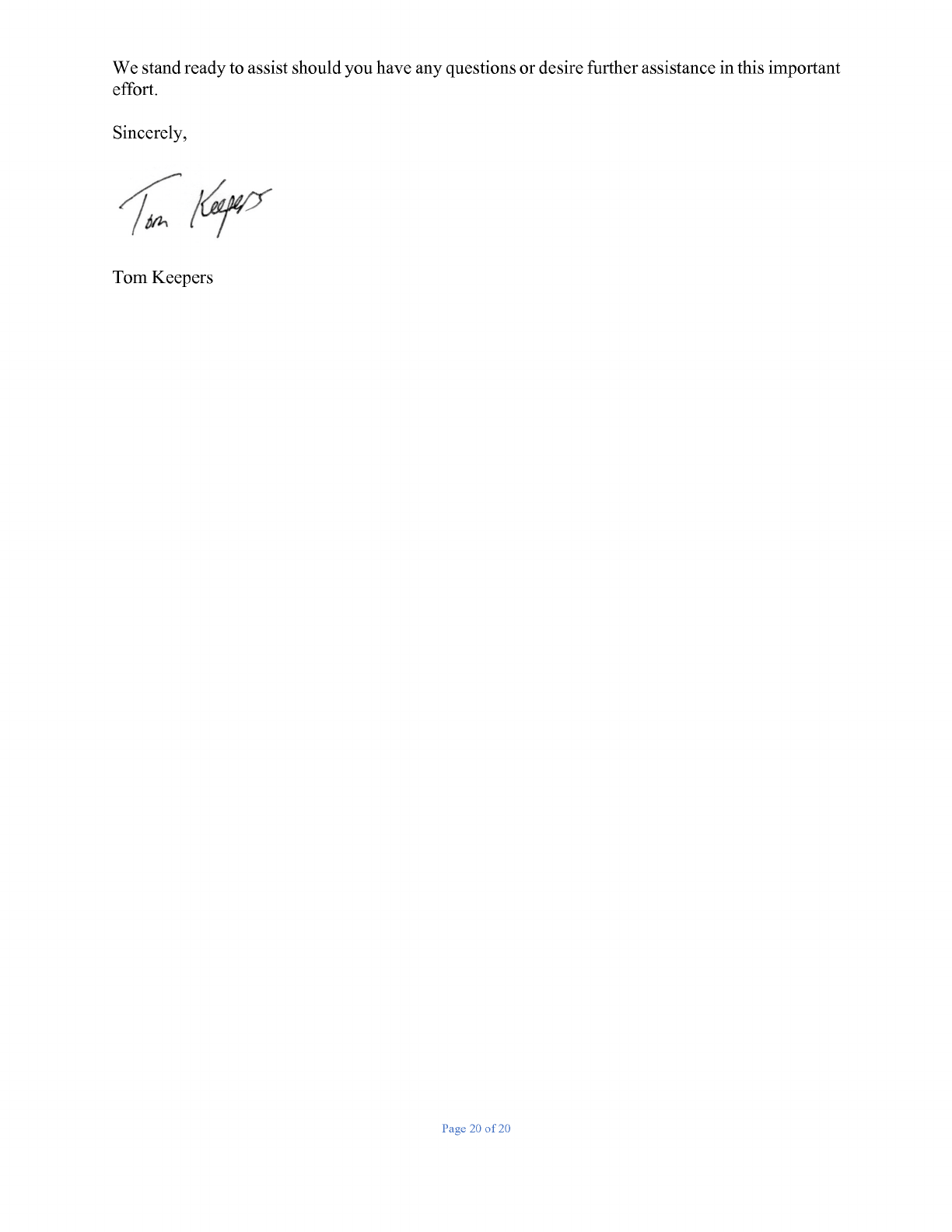
We
stand ready
to
assist should
you
have
any
questions
or
desire further assistance
in
this important
effort.
Sincerely,
Tom
Keepers
